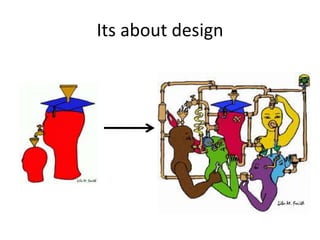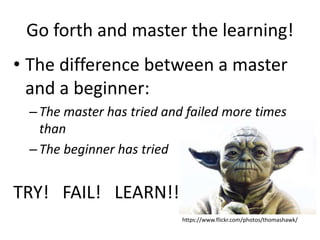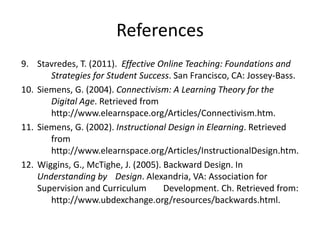Take a walk on the digital side: How purposeful use of tech and program design improves learning
- 1. Take a walk on the digital side: How purposeful use of tech and program design improves learning Randy LaBonte Canadian eLearning Network http://CANeLearn.net Canadian models integrating online learning environments
- 2. Why we are here (the promise…) • Together let's see how purposeful planning, design and use of technology may shift learning toward the promise and hype the rhetoric would have us believe. • To learn, and not do, is not yet to learn Your challenge is what you will do because of today?
- 3. Framing our conversation •What assumptions about learning, and specifically distributed or online learning, do you bring to this conversation??
- 4. Leadership, Technology & Pedagogy My thinking has been influenced by: • Doctoral research on leadership in technology- enhanced learning situations • Policy and practice consultation with the BC & AB online K-12 schools • Consulting with AB post-secondary • Interactions through CANeLearn.net • Teaching at VIU and RRU • Continuing research of online programs 4
- 5. My assumptions are framed by theory 1. Behaviourism 2. Cognitivism 3. Constructivism 4. Connectivism
- 7. My assumptions are influenced by the use of technology https://www.flickr.com/photos/lgb06/
- 8. Technology is the game changer… • Students today depend too much upon ink. They don’t know how to use a pen knife to sharpen a pencil. Pen and ink will never replace the pencil. National Association of Teachers, 1907 8
- 10. My most powerful learning moment • Describe a learning experience that really grabbed and excited you. • What was significant about it? • Tell someone about it…
- 11. Principles of Learning Learning is personal Learning is social Learning is contextual Learning is messy
- 12. • It is almost a miracle that modern teaching methods have not yet entirely strangled the holy curiousity of inquiry; for what this delicate little plant needs more than anything, besides stimulation, is freedom. • Albert Einstein
- 13. Ideal Learning Environment 1. The learner must be active. 2. The environment must be rich and complex. 3. The environment must be structured. 4. The learner must interact with others.
- 14. Its about design
- 15. Framing our conversation •What assumptions about learning, and specifically distributed or online learning, do you bring to this conversation??
- 18. Emerging Models • Navigate (BC) • Argyll (AB) • SC Cyber (AB) Wapaskewa (MB) • Consortia (BCLN, AB Moodle Hub, SK, OeLC, CFORP) • Blended Learning (NB, ON – LMS used in classrooms) • See http://canelearn.net/state-of-the-nation-k-12- online-learning-in-canada/state-of-the-nation-brief- issue-papers/ for more background
- 19. Trending… 1. Blended and online practices are blurring – it is more about learning within flexible structures 2. Transition from online to blended more difficult than from classroom to blended/online 3. Personalization and flexibility critical drivers in Canada – not competency-based as of yet 4. Research focus on better data and exploring pockets of innovation Online Blended Classroom
- 20. It is just learning after all… Campus Virtual Classroom DE Programs Onsite only Online only Flexible Learning • Instruction & learning is both onsite and online • Some element of choice in learning for students Blended and Online Learning Trends Emerging and Trending Shifts in Practices
- 21. e-Learning is… • Learner-centric • Instructor facilitates • Technology supports • From time constant, – Mastery variable; • To mastery constant, – Time variable
- 23. The Mantras… • e-Learning is any place, any pace, any time… • In 21st Century Learning, students use educational technologies to apply knowledge to new situations, analyze information, collaborate, solve problems, and make decisions.
- 24. Why?? • Personal learning • Any time/pace • We organized students into groups for efficiency in schools… • Why do we not do the same online? • What advantage do students achieve? Lose? 24
- 25. Stale learning activities… • Write down and describe a scenario, lesson, or evaluation strategy you think is stale or not where you would like it to be. • Pair up and brainstorm how to improve them.
- 27. Research conducted by Richard Light of Harvard: • One of the strongest determinants of student success was not instructor teaching style, rather the ability to form and participate in small study groups • Students who studied in groups: – More prepared for class – Better engaged in their studies – Learned significantly more than students who worked on their own Light, R.J. (2001) Importance of social interaction
- 28. • “High quality interaction with learning materials, interaction between teachers and learners and interaction among learners, are all essential for effective learning.” Bates, A.W. (2006), p.222 Quality and Interaction...
- 30. • Analysis of 400,000 students in 3000 schools found the most important predictor of quality was the teacher • Teacher effect on student achievement was both additive and cumulative Rice (2003) • The quality of a student’s teacher is the most important determinant of learning after family background. Hanushek (1992) The “X” Factor is?
- 32. Backward Design Focus on the learning – not the teaching
- 33. Basic Stages of UbD Stage 1:Identify desired results Curriculum Goals and Learner Outcomes Big Ideas Essential Questions/ Enduring Understandings Know/ Understand/ Do Stage 2: Determine acceptable evidence Formative/Summative Assessments Stage 3: Plan learning experiences and instruction Developing the Learning Plan Consider how to differentiate
- 34. Reflecting on your practice… • Community of Inquiry framework is the foundation for instructional practice, review, and reflection • Garrison, Anderson, & Archer (2000) https://coi.athabascau.ca/wp-content/uploads/2014/07/COI-ANIM.swf
- 35. Reproduced by permission of the publisher, © 2012 by tpack.org http://www.tpack.org
- 36. Designing flexible, engaging learning… Foundations (pick only one!): 1. Policy and funding • What is supporting? • What is required? • Strategies for change… 2. Curriculum alignment and assessment • Conflict or Concert? • Building congruence… 3. Organizational models • Blended Learning approaches • Changing horses in the middle of the stream… 4. Technology and Learning Resources • What is missing? • Where can you find it? 5. Teachers' technological and pedagogical skills • Strengths? • Challenges? • Strategies to support…
- 38. Go forth and master the learning! • The difference between a master and a beginner: –The master has tried and failed more times than –The beginner has tried TRY! FAIL! LEARN!! https://www.flickr.com/photos/thomashawk/
- 39. Contact Information Randy LaBonte [email protected] http://CANeLearn.net
- 40. References 1. Ally, M. (2004). Foundations of educational theory for online learning. In Terry Anderson and Fathi Elloumi (Eds.). Theory and Practice of Online Learning. Athabasca, AB: Athabasca University Press. 2. Bates, A.W. (2015). Teaching in a digital age: Guidelines for designing, teaching and learning for a digital age. Retrieved from http://www.tonybates.ca/teaching-in-a-digital-age/ 3. Dee Fink, L. (2003). A Self-Directed Guide to Designing Courses for Significant Learning. Retrieved from http:// www.deefinkandassociates.com/GuidetoCourseDesignAug05.pdf. 4. Downes, S. (2012). Connectivism and Connective Knowledge. Retrieved from http://www.downes.ca/files/Connective_ Knowledge-19May2012.pdf.
- 41. References 4. Drexler, Wendy. 2008, November 26. Networked Student. Retrieved from http://www.youtube.com/watch?v=XwM4ieFOotA. 5. Ferdig, R.E. & Kennedy, K. (2014). Handbook of research on K-12 online and blended learning. Retrieved from http://press.etc.cmu.edu/content/handbook-research-k-12-online- and-blended-learning-0 6. Hannum, W. (2005). Learning Theory Fundamentals. Retrieved from http://www.theoryfundamentals.com/gagne.htm 7. Harasim, L. (2012). Learning Theory and Online Technologies: How New Technologies are Transforming Learning Opportunities. New York, NY: Routledge Press. 8. Keller, J.M. (2010). Motivational Design for Learning and Performance: The ARCS Model Approach. New York, NY: Springer.
- 42. References 9. Stavredes, T. (2011). Effective Online Teaching: Foundations and Strategies for Student Success. San Francisco, CA: Jossey-Bass. 10. Siemens, G. (2004). Connectivism: A Learning Theory for the Digital Age. Retrieved from http://www.elearnspace.org/Articles/Connectivism.htm. 11. Siemens, G. (2002). Instructional Design in Elearning. Retrieved from http://www.elearnspace.org/Articles/InstructionalDesign.htm. 12. Wiggins, G., McTighe, J. (2005). Backward Design. In Understanding by Design. Alexandria, VA: Association for Supervision and Curriculum Development. Ch. Retrieved from: http://www.ubdexchange.org/resources/backwards.html.










































